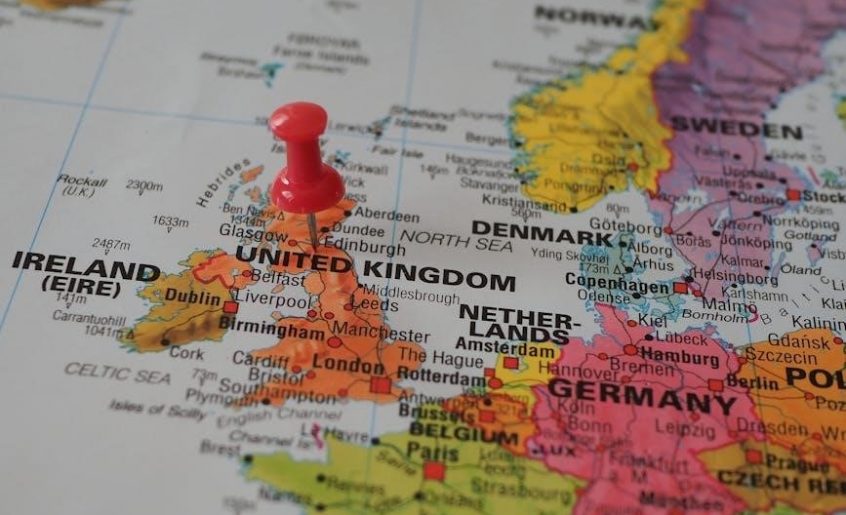This unit explores global connections from 1450 to 1750‚ focusing on the Columbian Exchange‚ maritime trade networks‚ the African Slave Trade‚ technological advancements‚ and cultural exchanges. Key themes include the impact of these interconnections on social structures‚ economic developments‚ and the emergence of a globalized world. The study guide covers the exchange of plants‚ animals‚ diseases‚ and technologies‚ as well as the rise of piracy‚ the Manila Galleons‚ and the legacy of these transoceanic links shaping modern society.
Transoceanic interconnections‚ from 1450 to 1750‚ reshaped global history through maritime trade‚ cultural exchange‚ and the movement of people‚ goods‚ and ideas. This period saw the Columbian Exchange‚ the expansion of European trade networks‚ and the rise of the African Slave Trade‚ fundamentally altering societies‚ economies‚ and cultures worldwide‚ laying the groundwork for a interconnected global system.
The Columbian Exchange
The Columbian Exchange‚ initiated by Columbus’s voyages‚ facilitated the transfer of plants‚ animals‚ diseases‚ and technologies between the Americas and Afro-Eurasia. Crops like maize and potatoes transformed agriculture globally‚ while horses and livestock reshaped American landscapes. However‚ the exchange also brought devastating diseases‚ decimating indigenous populations and causing profound demographic and social shifts across the Americas and beyond.
2.1. The Exchange of Plants‚ Animals‚ and Diseases
The Columbian Exchange transferred crops like maize‚ potatoes‚ and cassava to Afro-Eurasia‚ boosting agricultural productivity. Animals such as horses‚ cattle‚ and pigs were introduced to the Americas‚ transforming ecosystems. Conversely‚ Europeans brought diseases like smallpox and influenza‚ leading to significant population declines among indigenous peoples due to their lack of immunity to these new pathogens.
2.2. Impact on the Americas and Afro-Eurasia
The Americas saw population declines due to introduced diseases like smallpox‚ devastating indigenous communities. Afro-Eurasia gained crops such as maize and potatoes‚ boosting food production and population growth. This exchange reshaped economies‚ societies‚ and cultures‚ creating lasting demographic and environmental changes across both regions while fostering global interconnectedness and cultural adaptation.
2.3. Social Transformations Resulting from the Exchange
The Columbian Exchange spurred significant social changes‚ fostering cultural blending and the emergence of creole identities. New crops and animals altered traditional labor systems‚ shifting gender roles and family structures. The influx of diverse populations reshaped social hierarchies‚ creating complex class systems. These transformations laid the groundwork for the multicultural societies seen today.
Maritime Trade Networks
Maritime trade networks expanded significantly‚ linking Europe‚ Asia‚ Africa‚ and the Americas. European powers established routes across the Atlantic‚ while the Manila Galleons connected Asia with the Americas. These networks facilitated the exchange of goods like spices‚ textiles‚ and precious metals. The rise of joint-stock companies and naval technologies further accelerated global commerce‚ reshaping economies and fostering wealth inequality.
3.1. Expansion of European Maritime Trade
European maritime trade expanded rapidly‚ driven by explorers like Columbus and Vasco da Gama. Portugal and Spain established sea routes to Asia and the Americas‚ fostering trade in spices‚ gold‚ and other commodities. Advances in navigation tools‚ such as the astrolabe and carrack ships‚ enabled safer and more efficient voyages‚ solidifying Europe’s role in global commerce and sparking economic transformation.
3.2. The Role of the Manila Galleons
The Manila Galleons were Spanish ships that connected the Philippines to Mexico from the 16th to 19th centuries. They facilitated trade of Asian goods like silk and porcelain for American silver‚ linking Asia and the Americas. This network promoted economic prosperity‚ cultural exchange‚ and the transfer of ideas‚ shaping global trade patterns and regional economies during this period.
3.3. The Rise of Piracy and Its Effects
Piracy flourished in the Caribbean and Atlantic during the 16th to 18th centuries‚ targeting lucrative maritime trade routes. Pirates disrupted global commerce‚ seizing valuable cargo and destabilizing economies. European powers responded by strengthening naval presence and implementing anti-piracy laws. Piracy also influenced cultural perceptions‚ romanticized in folklore‚ while its economic impact reshaped trade strategies and maritime security measures globally.
The African Slave Trade
The transatlantic slave trade was a brutal system where millions of Africans were forcibly transported to the Americas. European powers exploited African societies‚ disrupting populations and economies. Enslaved Africans were integral to the development of new world economies‚ particularly in agriculture. This trade reshaped demographics‚ cultures‚ and labor systems‚ leaving enduring social and economic legacies.
4.1. Causes and Mechanisms of the Slave Trade
The African Slave Trade arose from European demand for labor in the Americas‚ driven by the Columbian Exchange and the need for workforce in plantations. African kingdoms and European colonizers collaborated in capturing and selling enslaved people. The mechanism involved wars‚ raids‚ and treaties‚ with enslaved individuals exchanged for goods like guns and textiles‚ fueling the triangular trade system.
4.2. The Middle Passage and Its Impact
The Middle Passage was the deadly transatlantic journey of enslaved Africans to the Americas‚ marking a horrific chapter in human history. Millions perished due to overcrowding‚ disease‚ and brutal conditions. Survivors faced psychological trauma and forced labor‚ shaping the transatlantic slave trade’s devastating legacy and its profound impact on enslaved individuals and their descendants.

4.3. Demographic and Social Consequences
The transatlantic slave trade drastically altered demographics‚ depopulating Africa while increasing enslaved populations in the Americas. Social structures in Africa were disrupted‚ and enslaved communities in the Americas faced brutal conditions. The trade entrenched racial hierarchies‚ perpetuating inequality and shaping long-term social and cultural dynamics‚ including the emergence of creole cultures and enduring legacies of institutionalized racism.
Technological Advancements
Technological innovations in navigation and shipbuilding‚ such as the astrolabe and carrack‚ enabled explorers to traverse vast oceans. These advancements facilitated global trade and cultural exchange‚ while improvements in metallurgy and engineering further supported maritime expansion. Such technologies were crucial in establishing and maintaining transoceanic connections‚ driving economic growth and shaping the interconnected world of the early modern era.
5.1. Developments in Navigation and Shipbuilding
Advancements in navigation tools‚ such as the astrolabe‚ and shipbuilding techniques‚ including the design of carracks‚ enabled explorers to traverse vast oceans more efficiently. These innovations facilitated transoceanic voyages‚ ensuring safer and more reliable travel‚ which in turn spurred global exploration and trade during this period.

5.2. The Role of Technology in Facilitating Trade

Technological innovations in navigation and shipbuilding enhanced trade efficiency‚ enabling faster and safer transoceanic journeys. These advancements expanded trade networks‚ increasing the volume of goods exchanged and facilitating cultural and economic interconnections between distant regions‚ fostering global commerce and the exchange of ideas during the 1450 to 1750 period.
5.3. Cultural Exchange Through Technology
Technological advancements facilitated the exchange of ideas‚ religions‚ and cultural practices across vast distances. Innovations like the printing press and improved navigation tools enabled the spread of knowledge‚ while maritime technologies connected diverse societies‚ fostering cross-cultural interactions and the blending of traditions during the 1450 to 1750 period.
The Silk Road and Other Overland Routes
The Silk Road and other overland routes connected Europe‚ Asia‚ and Africa‚ facilitating the exchange of goods like silk‚ spices‚ and precious stones. These pathways also enabled the spread of ideas‚ religions‚ and technologies. Complementing maritime trade‚ they fostered cultural exchanges‚ blending traditions and spreading religions such as Buddhism and Islam across vast regions.
6.1. The Continued Importance of Overland Trade
Overland trade remained vital‚ connecting regions through established routes like the Silk Road. It ensured the exchange of goods‚ ideas‚ and technologies between distant areas‚ complementing maritime networks. Key items such as spices‚ textiles‚ and metals were efficiently transported over land‚ maintaining economic and cultural ties between Europe‚ Asia‚ and Africa‚ even as transoceanic routes expanded.
6.2. The Complementarity of Maritime and Overland Routes
Maritime and overland routes were not competitors but complementary systems. Maritime trade excelled in bulk goods like grains and metals‚ while overland routes specialized in luxury items such as spices and fine textiles. Together‚ they facilitated a seamless exchange of goods‚ ideas‚ and cultures across vast distances‚ enriching economies and societies globally during this period of interconnectedness.
6.3. The Exchange of Goods and Ideas
The Silk Road and other overland routes facilitated the exchange of goods like silk‚ spices‚ and tea‚ while ideas such as Buddhism‚ Islam‚ and philosophical concepts spread widely. This cross-cultural exchange enriched societies‚ fostering innovation and understanding‚ and laid the groundwork for a more interconnected and diverse global community during this transformative period.
The Impact on Social Structures
Transoceanic interconnections transformed social structures by reshaping family dynamics‚ labor systems‚ and community organizations. The introduction of new crops and technologies altered daily life‚ while the movement of people led to cultural blending. Gender roles evolved as societies adapted to new economic realities‚ and the influx of diverse populations created complex social hierarchies and identities across the globe during this period.
7.1. Changes in Family and Community Structures
Transoceanic interconnections reshaped family and community structures through the Columbian Exchange‚ introducing new crops and technologies that altered daily life. The movement of people and goods led to cultural blending‚ while diseases disrupted traditional social norms. These changes created new labor roles and gender dynamics‚ fundamentally transforming family units and community organizations across the Americas and Afro-Eurasia.
7.2. The Role of Gender in Shaping Social Change
The Columbian Exchange and maritime trade networks reshaped gender roles‚ as women in the Americas and Afro-Eurasia adapted to new agricultural practices and economic systems. The introduction of crops like maize and potatoes allowed women to take on more prominent roles in food production‚ while the slave trade and migrations disrupted traditional gender norms‚ fostering new social dynamics and labor systems.
7.3. The Emergence of New Labor Systems
The Columbian Exchange and transoceanic trade spurred new labor systems‚ including plantation agriculture and enslaved labor. The introduction of crops like sugar and tobacco demanded large workforces‚ leading to the expansion of slavery. Maritime trade networks and the African Slave Trade intensified these systems‚ reshaping economies and societies across the Americas‚ Africa‚ and Europe.
Economic Developments
Transoceanic interconnections spurred economic growth through expanded trade networks‚ resource exchange‚ and the rise of global markets. The Columbian Exchange introduced new crops‚ boosting agricultural productivity. Maritime trade systems‚ including the Manila Galleons‚ facilitated wealth accumulation‚ while the African Slave Trade supported plantation economies. Technological advancements in navigation and shipbuilding further fueled economic expansion‚ creating both prosperity and inequality across regions.
8.1. The Growth of Wealth and Inequality
Wealth disparities widened as transoceanic trade concentrated riches among European elites and merchants. The exploitation of resources and labor in colonies enriched some while impoverishing indigenous populations. The African Slave Trade further exacerbated inequality‚ as the profits from plantations accrued to slave owners. This period saw the emergence of a global economy marked by both prosperity and significant social disparities.
8.2. The Emergence of a Global Economy
Transoceanic connections fostered the emergence of a global economy‚ linking regions through expanded trade networks. The Columbian Exchange and maritime routes facilitated the flow of goods‚ ideas‚ and cultures. Silver from the Americas fueled trade with China‚ while European merchants dominated global commerce. This period marked the integration of diverse economies into a single‚ interconnected system‚ laying the foundation for modern global trade.
8.3. Regional Economic Shifts
The Columbian Exchange and maritime trade led to significant regional economic shifts. Wealth flowed from the Americas to Europe‚ enriching nations like Spain and Portugal. Asian economies‚ particularly China and India‚ experienced disruptions as European dominance grew. The integration of new regions into global trade networks reshaped economic power dynamics‚ favoring European expansion and altering traditional economic balances globally.
Cultural Exchanges
Transoceanic interconnections facilitated cultural exchanges‚ blending traditions‚ religions‚ and ideas across vast regions. Syncretism emerged as cultures merged‚ creating new practices and identities. The spread of knowledge‚ technologies‚ and languages enriched societies‚ while creole cultures developed in diverse regions‚ reflecting the dynamic interaction of global communities. These exchanges fostered mutual understanding and shaped the cultural diversity of the modern world.
9.1. The Syncretism of Religions and Beliefs
Transoceanic interconnections led to the blending of religions and beliefs‚ creating syncretic practices. Indigenous traditions merged with Christianity‚ Islam‚ and African spiritualities. For example‚ Latin American cultures combined Catholicism with pre-Columbian rituals‚ while African diasporic communities integrated their beliefs into new religions like Vodou and Santería. This syncretism reflected cultural resilience and adaptation‚ shaping diverse spiritual identities and communities globally.
9;2. The Spread of Ideas and Knowledge
Transoceanic connections facilitated the exchange of ideas‚ technologies‚ and knowledge across vast regions. Scholars‚ travelers‚ and traders disseminated scientific discoveries‚ philosophical concepts‚ and cultural practices. The printing press‚ for instance‚ spread rapidly‚ enabling the widespread dissemination of written knowledge. This intellectual exchange fostered cross-cultural understanding and innovation‚ shaping the intellectual landscape of the early modern world and laying the groundwork for global intellectual advancements.
9.3. The Development of Creole Cultures
Creole cultures emerged as a result of transoceanic interactions‚ blending languages‚ traditions‚ and identities from Africa‚ Europe‚ and the Americas. Enslaved Africans‚ European colonizers‚ and indigenous peoples created new cultural forms‚ such as Creole languages and musical genres. These hybrid cultures reflected resilience and adaptation‚ becoming central to the identity of many regions shaped by global connections.
The transoceanic interconnections from 1450 to 1750 profoundly reshaped global societies‚ economies‚ and cultures. The Columbian Exchange‚ maritime trade networks‚ and the African Slave Trade created new systems of exchange‚ fostering cultural blending and economic interdependence. These connections laid the foundation for globalization‚ leaving a lasting legacy that continues to influence the modern world.
10.1. The Legacy of Transoceanic Interconnections
The legacy of transoceanic interconnections is marked by profound global transformations. The Columbian Exchange reshaped ecosystems and cultures‚ while maritime trade networks and the African Slave Trade drove globalization. These connections fostered technological advancements‚ cultural exchanges‚ and demographic shifts‚ laying the groundwork for modern global systems and continuing to influence societies economically and socially today.
10.2. The Shaping of the Modern World
Transoceanic interconnections laid the foundation for the modern world by fostering globalization‚ economic systems‚ and cultural diversity. The rise of European maritime powers‚ the establishment of colonies‚ and the integration of global trade networks created power imbalances and shaped identities. These connections continue to influence contemporary global structures‚ economies‚ and societies‚ underscoring their enduring legacy.

10.3. The Enduring Impact on Global Society
Transoceanic interconnections permanently reshaped global society by fostering cultural syncretism‚ economic interdependence‚ and social hierarchies. The exchange of ideas‚ goods‚ and populations created lasting legacies‚ including globalized trade systems‚ cultural blending‚ and persistent social inequalities. These connections continue to influence contemporary issues‚ such as globalization‚ identity formation‚ and economic disparities‚ making their impact indelible in modern times.
